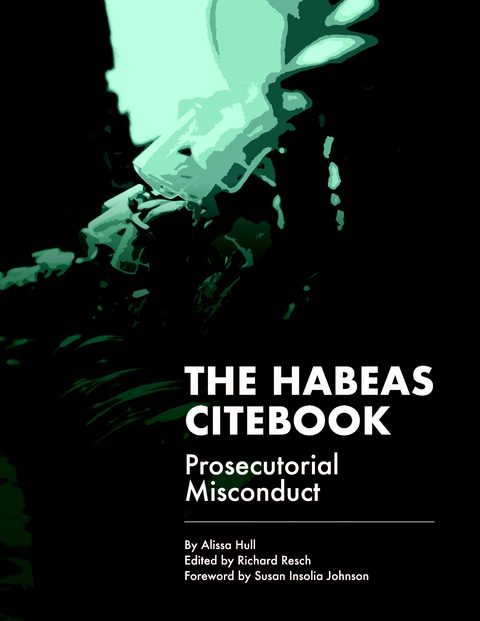How to Take Your Postconviction Case Directly to the U.S. Supreme Court: A Roadmap to Direct Collateral Review
by Dale Chappell
For prisoners who have exhausted their state postconviction options, the path to relief in federal court is filled with obstacles. Many assume that the only option is federal habeas corpus under 28 U.S.C. § 2254, but the Antiterrorism and Effective Death Penalty Act (“AEDPA”) has made that process incredibly difficult. For example, federal courts are required to defer to state court rulings unless those rulings are not only wrong but unreasonably wrong, and the one-year statute of limitations, procedural default rules, and stringent requirements for obtaining relief leave most federal habeas petitions dead on arrival.
Direct Collateral Review (“DCR”) offers a different approach. Rather than filing a habeas petition in a United States District Court, DCR allows a prisoner to take their case directly from the state court to the U.S. Supreme Court. This process bypasses AEDPA entirely, meaning there are fewer obstacles for a federal court to hear the claims. Understanding whether DCR is the right option and following the correct steps to file can make the difference between keeping a case alive and losing the last opportunity for relief.
Understanding Direct Collateral Review
DCR is an appeal from a state postconviction ruling to the Supreme Court. The process is governed by 28 U.S.C. § 1257(a), which allows the Supreme Court to review final judgments from state courts that involve federal constitutional issues. A prisoner becomes eligible for DCR only after exhausting all postconviction remedies in the state courts. This means that the prisoner must have filed a state habeas corpus or postconviction relief motion, appealed any denial through the state appellate system, and received a final ruling from the state’s highest court. Once that final ruling is issued, the prisoner has the option to petition the Supreme Court for review through a writ of certiorari—an order by a higher court directing a lower court to provide the records of a case in order to review the lower court’s decision.
DCR is distinct from federal habeas corpus under § 2254, which is filed in a U.S. District Court, then appealed to the appropriate U.S. Court of Appeals before reaching the Supreme Court. AEDPA governs § 2254 proceedings, imposing a strict one-year filing deadline and requiring prisoners to prove that the state court’s ruling was not just incorrect but unreasonably so. Procedural default rules also bar many claims from being heard, and new evidence is rarely considered in federal court. None of these restrictions apply to DCR. Because DCR involves an appeal rather than a habeas petition, the Supreme Court is not bound by AEDPA’s stringent limitations. However, this does not mean DCR is an easy path. The Supreme Court accepts only a small percentage of cases, selecting those that address broad constitutional questions rather than individual claims of wrongful conviction.
When to Use Direct Collateral Review
DCR is only effective when a case presents a federal constitutional issue that the Supreme Court has the authority to resolve. It is more likely to grant review when a state court ruling directly contradicts Supreme Court precedent, when the case presents an important constitutional question that has not been fully addressed before, or when there is an issue that affects many people that the Supreme Court must address.
The Supreme Court does not function as an error-correcting court. It does not take cases simply because a state court got the law wrong. Instead, it focuses on cases that clarify constitutional law at a national level. A strong DCR case might involve a state court misapplying a Supreme Court decision, such as refusing to apply Brady v. Maryland, 373 U.S. 83 (1963), in a case involving withheld exculpatory evidence. A case may also qualify if a state court refuses to apply a new Supreme Court ruling retroactively, despite precedent requiring it, as in Montgomery v. Louisiana, 577 U.S. 190 (2016).
DCR is not the correct strategy if a claim requires new evidence, an evidentiary hearing, or a review of factual disputes in federal court. The Supreme Court does not hold hearings or review trial records. If a prisoner needs to develop new facts or argue ineffective assistance of counsel based on evidence outside the trial record, federal habeas corpus under § 2254 is the better option.
Steps to Filing for Direct Collateral Review in the U.S. Supreme Court
Filing for DCR in the Supreme Court is a complex process, but if done correctly, it allows a prisoner to take their postconviction case directly from the state courts to the highest court in the country. The process starts in the state courts and must be followed step by step before reaching the Supreme Court. Failing to complete any stage correctly can result in forfeiting the right to review.
Step One: Exhausting State Postconviction Remedies
Before you can file for DCR, you must first exhaust all available postconviction remedies in state court. This means filing a postconviction relief motion or state habeas petition, depending on what it is called in your state. Once you file the postconviction motion in the trial court, you must litigate it fully through the state system. If the trial court denies relief, you must appeal that decision to the state appellate court. If that court also denies relief, you must then seek review from the state’s highest court. This could be the state supreme court or, in some states, an intermediate appellate court if the state supreme court (or alternatively named highest court in the state) refuses to hear postconviction cases. You cannot skip this step. The Supreme Court will not hear your case unless the state’s highest court has issued a final decision denying relief.
Step Two: A Petition in the U.S. Supreme Court, Not a § 2254 Petition in Federal District Court
Some prisoners have erroneously believed that DCR means exhausting their state postconviction remedies and then filing a habeas corpus petition under § 2254 in federal district court. That is the standard process for federal habeas cases, but that is not the correct procedure if you are seeking DCR in the U.S. Supreme Court.
Instead of filing in district court and going through the federal appellate system, you take your case directly to the Supreme Court by filing a petition for a writ of certiorari. This is a crucial distinction. If you file a habeas petition in federal district court instead of filing for certiorari, you forfeit the opportunity for DCR because once you enter the federal habeas process, your case is bound by AEDPA’s strict limitations. If you are unfamiliar with Supreme Court procedure—and most are not—the Court provides a handy packet upon request for free. Contact the Clerk of the Supreme Court to request this packet.
Step Three: Preparing a Certiorari Petition for the U.S. Supreme Court
Once the state’s highest court has denied relief, you must file a petition for a writ of certiorari with the Supreme Court. This is the document that formally asks the justices to review your case. One of the most common reasons the Court hears a case is when there is a split between state or federal courts on an important legal issue. If different courts have ruled differently on the same constitutional question, the Supreme Court may step in to establish a uniform rule for the entire country. If your case involves an issue where courts have reached conflicting decisions, that should be clearly explained in your petition.
Another strong basis for review is if your case involves a major constitutional question that affects a significant number of people. The Supreme Court often hears cases that deal with fundamental rights, criminal procedure, or due process violations that could impact many prisoners. If your case raises an issue of national importance—such as whether a certain sentencing practice is unconstitutional or whether a procedural rule unfairly blocks access to postconviction relief—you must emphasize that in your petition.
A third reason the Supreme Court may take a case is when a state court has ignored or misapplied Supreme Court precedent. If a state court refuses to follow a Supreme Court decision that directly applies to your case, the justices may take the case to correct the error. This happens when state courts interpret prior rulings too narrowly or create exceptions that effectively disregard Supreme Court decisions. If your case fits this scenario, your petition must demonstrate how the state court’s ruling conflicts with existing Supreme Court precedent.
Most petitions raise between one to three claims. Each claim must be carefully constructed to focus on a constitutional issue that satisfies the Court’s selection criteria. It is important to remember that you are not arguing that your conviction was unfair—you are arguing that your case presents a constitutional problem that the Supreme Court must address.
Step Four: Filing the Certiorari Petition on Time and in the Correct Format
The Supreme Court has strict rules governing how petitions must be filed, which are detailed in the “Rules of the Supreme Court of the United States.” For instance, the 90-day deadline is firm, and missing it means losing your opportunity for review. The petition must follow Rule 14, which governs structure and content, and Rule 33, which sets formatting requirements such as word limits, paper size, and binding. The rules and an example petition are included in the informational packet provided by the Clerk.
The Court also requires a filing fee, though prisoners who cannot afford this can apply to have the fee waived by filing a motion to proceed in forma pauperis (“IFP”). Even if you can afford this fee, it is a good idea to obtain IFP status since it relieves you of the obligation to provide numerous copies of your petition and other procedural demands.
Common Errors to Avoid When Filing for Direct Collateral Review
Many prisoners mistakenly believe that filing for DCR is as simple as taking their postconviction case to the Supreme Court after losing in state court. In reality, DCR is a highly specialized legal process, and missteps along the way can result in automatic dismissal. Some prisoners commit procedural errors that completely prevent the Supreme Court from hearing their case, while others structure their petitions in a way that guarantees denial. Understanding these common mistakes—and avoiding them—is critical to having your case heard by the Supreme Court.
The most frequent and damaging mistake is filing a federal habeas corpus petition in U.S. District Court instead of going directly to the Supreme Court. Prisoners who do this misunderstand the fundamental difference between DCR and federal habeas corpus under § 2254 and automatically deprive themselves of any chance for DCR.
With federal habeas, a petitioner must first file in U.S. District Court and then appeal through the federal system, with strict AEDPA rules limiting review. If a prisoner files a § 2254 petition instead of a certiorari petition, their case is automatically treated as a federal habeas case, meaning AEDPA’s restrictions will apply to all future proceedings. In other words, filing for habeas in U.S. District Court means losing the chance to seek DCR in the Supreme Court.
This mistake has been made repeatedly. Prisoners who filed in U.S. District Court instead of going straight to the U.S. Supreme Court have had their cases dismissed under AEDPA’s limitations, often because they failed to meet procedural requirements or filed outside the one-year statute of limitations. In some cases, prisoners mistakenly believed they could file for habeas relief first and subsequently pursue DCR, only to realize too late that the two processes are not interchangeable. Once a case enters the federal habeas system, it is no longer eligible for DCR.
Another common mistake is assuming that filing for DCR pauses AEDPA’s one-year deadline for habeas corpus in U.S. District Court. It does not. The one-year clock for federal habeas relief continues running while the Supreme Court considers a DCR petition. If a prisoner intends to file for both, they must carefully track their filing deadlines. Many prisoners have unknowingly lost their right to federal habeas review because they erroneously waited for the Supreme Court to rule on their DCR petition, only to discover later that the one-year habeas deadline had expired. This is why some prisoners choose to file for habeas first, while simultaneously pursuing DCR to avoid losing their opportunity for relief.
A final common mistake that has caused prisoners to squander their chance at Supreme Court review is failing to properly exhaust all state postconviction remedies before filing for DCR. The Supreme Court will not hear a case unless the state courts have issued a final ruling. Some prisoners, eager to seek federal review, attempt to file for certiorari after losing in an intermediate appellate court, without taking their case to the state’s highest court. This results in automatic dismissal, because the Supreme Court does not have jurisdiction unless the case has been fully litigated in the state system. 28 U.S.C. § 1257(a).
Choosing Between DCR and Federal Habeas Corpus
Deciding between DCR and federal habeas corpus under § 2254 is one of the most important strategic choices in postconviction litigation. DCR is a powerful tool because it allows a prisoner to take a case directly from the state courts to the Supreme Court without being subjected to AEDPA’s strict limitations. The purpose of a § 2254 petition is to allow a federal district court to examine whether a prisoner is being held in violation of federal law.
If a prisoner needs to present newly discovered evidence, claims of ineffective assistance of counsel requiring investigation, or other issues that demand factual development, habeas corpus is the better option. Federal district courts have the authority to hold evidentiary hearings and review state court findings under § 2254(d)(2), which applies when a state court made an unreasonable determination of the facts based on the evidence before it. DCR does not provide this opportunity.
A prisoner pursuing both DCR and federal habeas must also be mindful that filing for DCR does not toll AEDPA’s one-year deadline for habeas. The one-year clock for filing a § 2254 petition keeps running while a certiorari petition is pending before the Supreme Court. If the deadline for habeas relief is approaching, it may be necessary to file for habeas first to preserve the right to federal review before pursuing DCR. Some prisoners choose to file both simultaneously, but this requires careful planning to ensure that both petitions are filed correctly and within the appropriate time limits.
Conclusion
With years of experience handling federal habeas corpus and DCR, I have seen firsthand how critical it is to take the appropriate legal path when pursuing postconviction relief. DCR provides a unique opportunity to bypass AEDPA and seek direct review from the Supreme Court. For those whose cases are barred by the AEDPA, DCR may be the best option for federal review. For others who need evidentiary hearings, fact development, or a deeper examination of trial errors and who are within the AEDPA time limits, federal habeas corpus under § 2254 is often the better choice. Postconviction litigation is exceptionally complex, and receiving competent legal guidance can mean the difference between a case moving forward and outright dismissal.
As a digital subscriber to Criminal Legal News, you can access full text and downloads for this and other premium content.
Already a subscriber? Login





